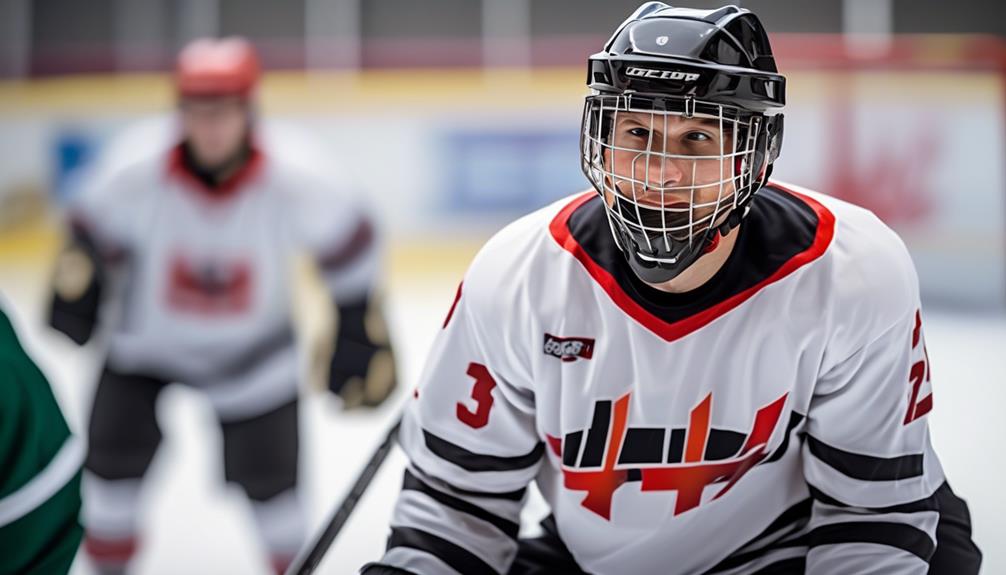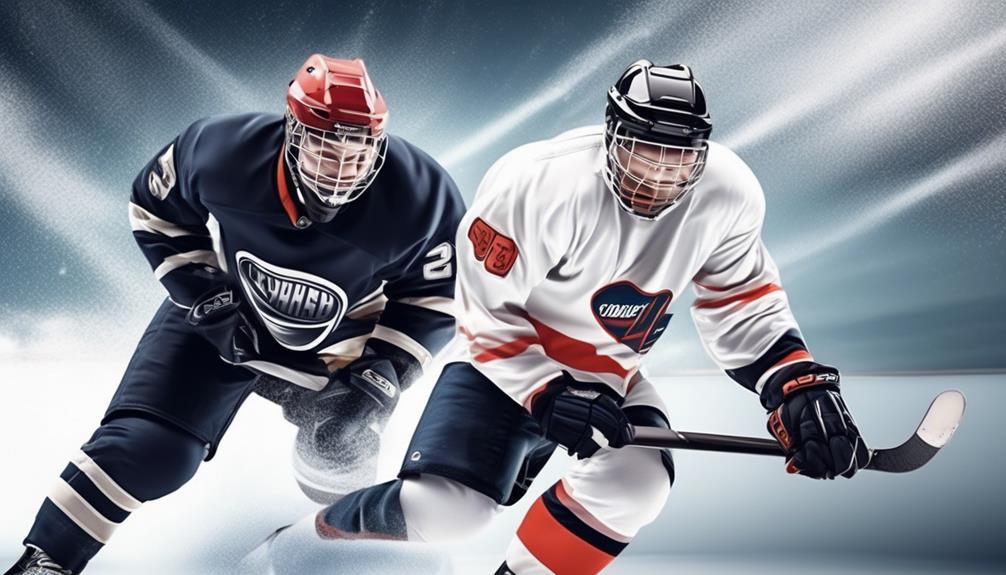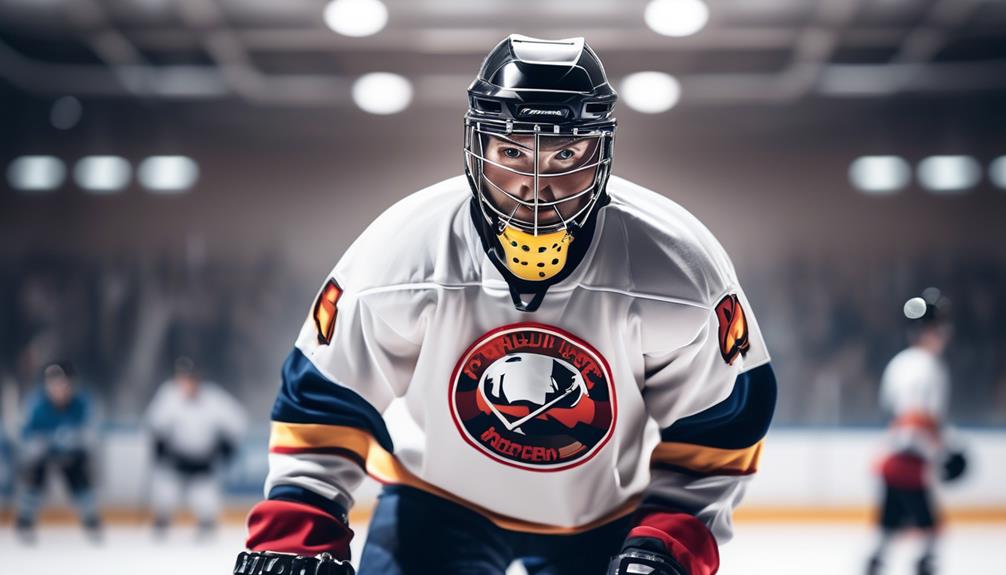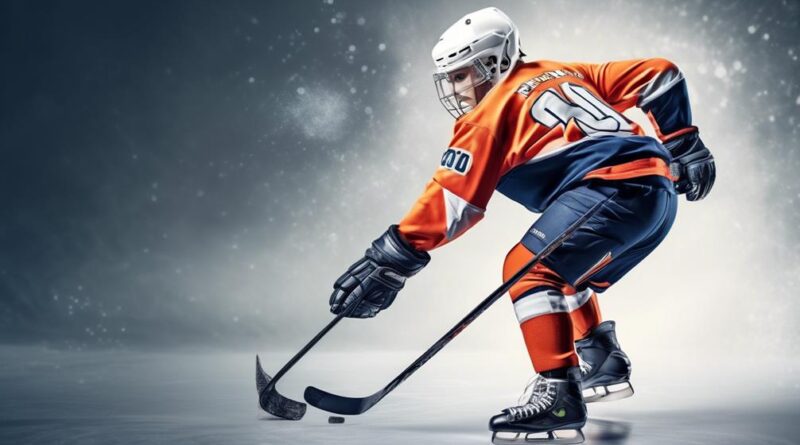Why Is Proper Hockey Gear Crucial for Injury Prevention?
You lace up your skates, grab your stick, and hit the ice with an adrenaline rush, ready for a fast-paced game of hockey. But amidst the exhilaration of the sport, there's an essential aspect that often goes unnoticed: the critical role of proper hockey gear in preventing injuries.
From helmets to shoulder pads, each piece serves as a vital safeguard against potentially serious harm. But why exactly is it so crucial? Well, let's just say, the difference it can make might surprise you.
Importance of Proper Helmet Fitting

Ensuring a snug and secure fit for your hockey helmet is paramount in protecting against head injuries during play. Proper helmet fitting is crucial for maximizing the benefits of advanced helmet technology designed for concussion prevention and impact absorption. When fitting your hockey helmet, it's essential to pay attention to specific areas to ensure optimal protection.
Helmet technology has advanced significantly in recent years to enhance player safety on the ice. Modern helmets are equipped with advanced materials and innovative designs to effectively absorb and disperse impact forces, reducing the risk of concussions and head injuries. However, the effectiveness of these advancements heavily relies on the proper fitting of the helmet. A well-fitted helmet ensures that the advanced protective features are positioned correctly to provide maximum safety in the event of a collision or fall.
Concussion prevention is a critical aspect of helmet technology, and achieving the right fit is the first line of defense. A helmet that's too loose may shift upon impact, reducing its ability to absorb and dissipate force effectively. Conversely, a helmet that's too tight can lead to discomfort and may not provide adequate coverage. By meticulously adjusting the helmet's fit, you can ensure that it stays in place during play, offering the intended protection against potential head injuries.
Role of Shoulder Pads in Impact Protection
Shoulder pads play a crucial role in protecting hockey players from impact during gameplay. The design of shoulder pads is essential in providing the necessary protection while allowing for flexibility and mobility. Modern shoulder pad design incorporates advanced impact absorption technology, which helps disperse and minimize the force of impacts during collisions or falls on the ice.
The shoulder pad design typically consists of multiple layers, each serving a specific purpose in impact protection. The outer shell is often made of durable materials such as plastic or composite, providing a hard shield against direct hits and slashes. Beneath the outer shell, foam padding is strategically placed to absorb and distribute the force of impacts, reducing the risk of injuries to the shoulders, chest, and upper back. Additionally, some shoulder pads feature reinforced sternum and spine protection to safeguard vital areas from high-impact collisions.
Impact absorption technology integrated into shoulder pads utilizes advanced materials and innovative construction techniques to enhance protection without sacrificing comfort or maneuverability. These technologies often include lightweight yet resilient foams and gels that are engineered to effectively absorb and disperse energy upon impact, reducing the risk of trauma to the player's upper body.
Significance of Elbow Pads for Joint Safety

Wearing properly fitted and protective elbow pads is essential for safeguarding your joints from potential impacts and injuries during hockey gameplay. Elbow pad benefits are crucial in ensuring your joint protection, and here's why:
- Impact Absorption: Elbow pads are designed to absorb and disperse the force of impacts, reducing the risk of joint injuries and providing a layer of protection for your elbows during collisions or falls.
- Stability and Support: These pads offer stability to your elbows, helping to prevent hyperextension or hyperflexion during sudden movements, thereby reducing the risk of joint strains or sprains.
- Enhanced Confidence: Knowing that your elbows are well-protected can give you the confidence to play more aggressively and fearlessly, allowing you to focus on your game without the worry of potential joint injuries.
- Long-Term Joint Health: By consistently wearing elbow pads, you're investing in the long-term health of your joints, minimizing the risk of chronic injuries that could affect your ability to play hockey in the future.
- Peace of Mind: Wearing elbow pads provides peace of mind, allowing you to fully enjoy the game without the constant concern for your joint safety, ultimately enhancing your overall gaming experience.
Understanding the importance of elbow pads for joint safety is crucial for every hockey player. By prioritizing the use of these protective gears, you aren't only reducing the immediate risk of injuries but also promoting the longevity of your joint health in the sport.
Benefits of Wearing Protective Gloves
Providing essential protection for your hands, wearing protective gloves is vital for safeguarding against potential impacts and injuries during hockey gameplay.
Firstly, protective gloves offer crucial hand protection, shielding your hands from stick slashes, high-speed pucks, and accidental impacts with other players. This protection is essential for preventing lacerations, bruises, and more severe injuries to your hands during the fast-paced and physical nature of hockey.
Additionally, the gloves provide grip enhancement, allowing you to handle the stick more effectively and securely. This improved grip not only enhances your performance but also reduces the likelihood of the stick slipping from your hands, which could lead to potential accidents on the ice.
Furthermore, these gloves play a significant role in supporting wrist stability and mobility. The design of protective gloves includes features such as adjustable wrist straps and padding, which help to stabilize the wrist joint during gameplay. This support is crucial for preventing hyperextensions, sprains, and other wrist-related injuries that can occur while playing hockey.
At the same time, the gloves' design allows for sufficient mobility, enabling you to handle the stick, shoot, and pass with ease while still providing the necessary protection and support for your hands and wrists.
Essential Role of Shin Guards in Injury Prevention

After safeguarding your hands with protective gloves, it's essential to focus on the crucial role of shin guards in preventing lower body injuries during hockey gameplay. Shin guards play a vital role in protecting your lower legs from potential impacts and injuries.
Here are some reasons why shin guards are essential for injury prevention:
- Impact Absorption: Shin guards are designed to absorb and disperse the impact of pucks, sticks, and other players' skates, reducing the risk of serious injuries to your lower legs.
- Protection from Fractures: Shin guards provide a sturdy barrier that helps prevent fractures and breaks in the shin bone, which can occur during collisions or direct hits.
- Prevention of Contusions: By effectively covering the shin and ankle areas, shin guards minimize the risk of painful contusions and bruises caused by fast-moving pucks or accidental hits.
- Enhanced Confidence: Wearing shin guards can boost your confidence on the ice, allowing you to focus on the game without fear of potential lower body injuries.
- Long-Term Health Benefits: Investing in high-quality shin guards can contribute to your long-term health by reducing the likelihood of chronic leg injuries that may develop over time.
The effectiveness of shin guards in injury prevention can't be overstated. By prioritizing the protection of your lower body, you can enjoy the game with reduced risk of severe injuries, ensuring that you can continue to play hockey for years to come.
Impact of Proper Skates on Ankle Support
Invest in well-fitted skates to ensure optimal ankle support and stability during hockey gameplay. Ankle stability is crucial in hockey, as it can significantly impact your performance and reduce the risk of injuries. Properly fitted skates provide the necessary ankle support to help prevent sprains and strains, allowing you to move with confidence and agility on the ice.
When your skates offer proper ankle support, you'll experience enhanced performance on the ice. With improved stability, you can make quick turns, sudden stops, and powerful strides without fear of rolling or twisting your ankle. This stability allows you to exert more force and control in your movements, ultimately boosting your overall hockey performance.
It's important to note that skates should be snug but not overly tight, as this can restrict blood flow and lead to discomfort or even injury. Ensure that the skates provide support around your ankle bones while still allowing for some flexibility. Additionally, consider skates with features such as ankle padding and reinforced ankle support to maximize stability and reduce the risk of ankle-related injuries.
Investing in proper skates with adequate ankle support is an essential aspect of injury prevention and performance enhancement in hockey. By prioritizing ankle stability, you can skate with greater confidence, minimize the risk of ankle injuries, and optimize your overall gameplay experience.
Value of Mouthguards in Dental Protection

Investing in well-fitted skates not only enhances ankle stability but also allows you to focus on protecting your teeth with the value of mouthguards in hockey.
Mouthguards are a crucial piece of protective gear in hockey, as they help prevent dental injuries and concussions. When it comes to mouthguard types, you have several options to choose from, including custom-fitted mouthguards, boil-and-bite mouthguards, and ready-to-wear mouthguards. Each type offers varying levels of comfort and protection, so it's essential to select one that suits your needs and preferences.
Additionally, maintaining your mouthguard is vital for its effectiveness and longevity. Proper maintenance tips include rinsing it with cold water after each use, storing it in a ventilated container, and regularly checking for any signs of wear and tear. By taking these maintenance measures, you can ensure that your mouthguard continues to provide optimal protection for your teeth and mouth.
- Custom-fitted mouthguards offer the best protection and comfort.
- Boil-and-bite mouthguards provide a balance between comfort and affordability.
- Ready-to-wear mouthguards are convenient but may not offer the best fit.
- Regular maintenance ensures your mouthguard remains effective and hygienic.
- Protecting your teeth with a mouthguard safeguards your dental health and overall well-being.
Role of Neck Guards in Preventing Neck Injuries
Wearing a properly fitted neck guard is essential for preventing neck injuries while playing hockey. The effectiveness of neck guards in preventing neck injuries can't be overstated. In the fast-paced and physical game of hockey, players are at risk of sustaining neck injuries from high-velocity impacts, collisions, and falls. A well-designed neck guard can significantly reduce the risk of severe neck injuries and provide added protection to the vulnerable neck area.
The impact of neck injuries in hockey can be severe, ranging from muscle strains to more serious cervical spine injuries. Neck guards play a crucial role in minimizing the risk of such injuries by providing a layer of cushioning and support to the neck. By absorbing and dispersing the force of impacts, neck guards help to reduce the likelihood of hyperextension, hyperflexion, and other harmful movements that can lead to neck injuries. Additionally, they can also offer protection against lacerations and abrasions to the neck area, further enhancing player safety on the ice.
When it comes to injury prevention, investing in high-quality neck guards is a non-negotiable aspect of hockey gear. Players should prioritize comfort and proper fit when selecting a neck guard, ensuring that it provides adequate coverage and protection without restricting movement. By recognizing the importance of neck guards and incorporating them into their essential equipment, hockey players can significantly reduce the risk of sustaining debilitating neck injuries during gameplay.
Frequently Asked Questions
Is There a Specific Age at Which Children Should Start Wearing Hockey Gear for Injury Prevention?
You should start wearing hockey gear for injury prevention at a young age. Proper gear is necessary to protect you from potential injuries. Parents often have concerns, but it's important to prioritize safety over peer pressure.
How Often Should Hockey Gear Be Replaced to Ensure Maximum Protection?
To ensure maximum protection, replace hockey gear regularly. Proper maintenance and quality gear are crucial for injury prevention. Impact of gear quality is significant in preventing injuries, so stay on top of gear replacement.
Are There Any Specific Guidelines for Fitting and Adjusting Hockey Gear for Optimal Safety?
When fitting hockey gear, it's vital to ensure proper sizing for optimal safety. Follow specific guidelines for adjusting equipment to minimize injury risk. Regular gear maintenance and adherence to safety guidelines are essential for injury prevention.
What Are the Most Common Injuries That Can Occur if Hockey Gear Is Not Worn or Fitted Properly?
Without proper fitting, common hockey injuries such as concussions, sprains, and fractures can occur. It's crucial to ensure your gear fits well to prevent these injuries. Make sure to regularly check and adjust your equipment for optimal safety.
Are There Any Specific Training Exercises or Techniques That Can Complement the Use of Hockey Gear for Injury Prevention?
To complement proper hockey gear for injury prevention, training techniques like plyometrics, agility drills, and strength training can be effective. These exercises enhance gear complementation by improving overall physical conditioning and reducing injury risk on the ice.
Conclusion
So, remember to always wear the proper hockey gear to keep yourself safe on the ice. Your helmet, shoulder pads, elbow pads, gloves, shin guards, skates, mouthguard, and neck guard all play a crucial role in preventing injuries.
Don't take any shortcuts when it comes to your safety – make sure your gear fits properly and is in good condition before hitting the ice.
Stay safe and enjoy the game!
